How to check if your WordPress blog post ranks for the right keywords
Apr 20, 2025 am 07:45 AMDo you want to check if your WordPress posts rank for the correct keywords?
Most beginners manually check the ranking of their articles by typing keywords into Google. This doesn't give you an accurate picture of where your article represents the target keyword.
In this article, we will show you how to easily check if your WordPress blog posts rank for the right keywords.

Why check keyword rankings for WordPress posts?
If you follow our complete WordPress SEO guide, you will learn how to optimize every post on your website for specific keywords. This can help you get more website traffic.
Most beginners just search on Google to see if their posts appear in these keywords. Even so, they usually only check the first or second page at most.
The problem is that sometimes your post can rank well below the first two pages, or worse yet, it may not even get the ranking of the keywords you want.
If you rely on manually checking keyword rankings, you'll miss out on useful information that can be used to improve SEO rankings and increase traffic.
That being said, let's take a look at how to properly check keyword rankings for WordPress blog posts. We will introduce three different keyword reference tools and then show how to use keyword ranking information to increase traffic to your website:
- Use Semrush to check keyword rankings
- Check keyword rankings with Google Search Console
- Check keyword rankings in WordPress using AIOSEO (recommended)
- Check keyword rankings with Ahrefs
- Get more traffic in WordPress using keyword ranking
- Understand the behavior of visitors on your website
Method 1: Use Semrush to view keyword rankings
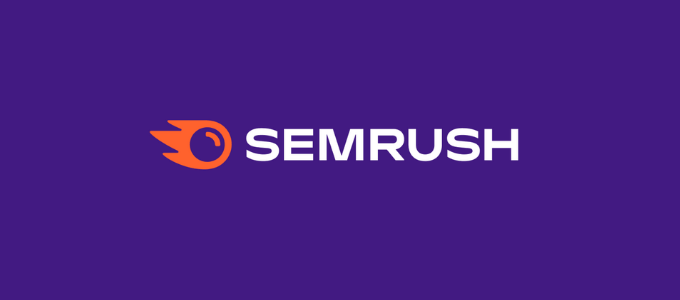
Semrush is one of the best SEO and keyword research tools on the market. It is a comprehensive SEO suite with all the useful tools you need.
It comes with powerful organic research tools that can display keyword rankings for any domain name. You do not need to enter the URL of individual articles. Instead, it automatically gets the results for all URLs on the domain name.
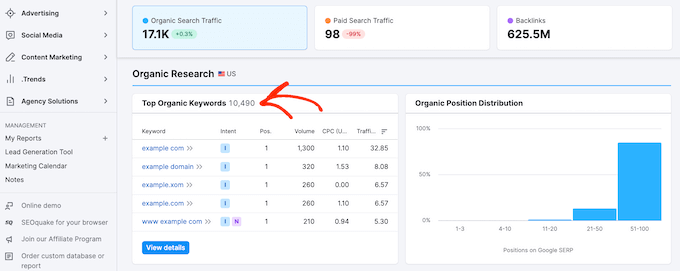
Simply enter the domain name you are looking for and Semrush will get a lot of information. After that, click the Organic Research tab to view a complete list of all keywords for your website rankings.
You can sort the results by location, URL, traffic, etc. You can also export the results to a CSV file and use your favorite spreadsheet program for offline research.
You can also use Semrush to track specific keywords, which will track on the dashboard so you can see how they perform immediately.
Semrush can also perform these operations on any domain name. This means you can enter your competitor's domain name and see which keywords they rank.
You can also see their paid search traffic, paid keywords, and other useful information that you can use to surpass them.
Method 2: Use Google Search Console to check keyword rankings
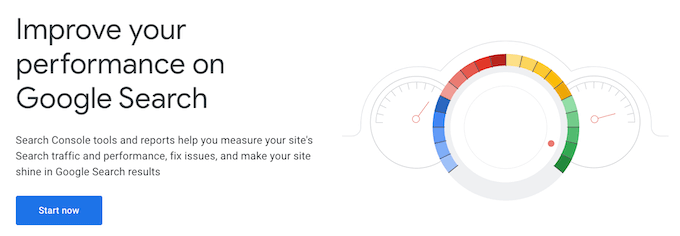
Google Search Console (formerly known as Google Webmaster Tools) is a set of tools provided by Google to help webmasters improve their search websites. You can check out our guide on how to add your website to Google Search Console.
At the top of the Performance tab, you will see a graph of the website's performance in the search results.
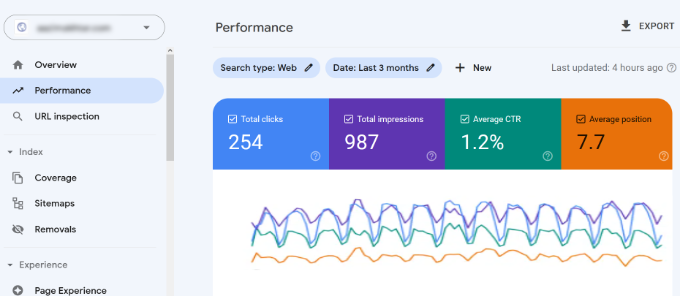
When you scroll down, you will see the keyword data. Next to each keyword, you can see how many clicks and impressions it gets and where it is on the search results page.
You can sort this data by clicking on any column.
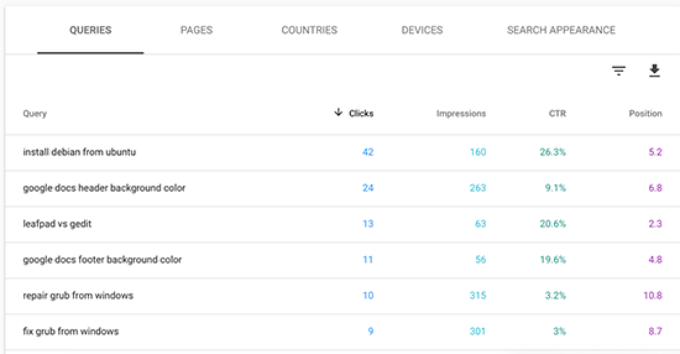
If you sort the list by position, you will be able to see the top keywords. When you scroll down the list, you will see your website displaying lower keywords on the search engine results page.
You can also export this data and open it with your favorite spreadsheet software.
Method 3: Use AIOSEO to check the internal keyword ranking of WordPress (recommended)
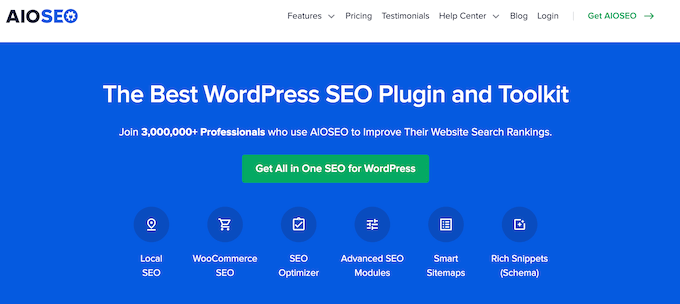
All in One SEO (AIOSEO) is one of the best WordPress SEO plugins on the market, used by more than 3 million professionals. This complete SEO toolkit will help you easily optimize your WordPress blog for better search rankings.
Additionally, it comes with a search statistics plugin that allows you to view top-ranked content, best-performing keywords, and other important SEO statistics.
This method allows you to check the ranking of articles directly in WordPress. Therefore, you don't need to switch between WordPress and Google Search Console to find the data you want, saving time.
Once you connect your search statistics to the Google Search Console, you can click Search Statistics in the AIOSEO menu of the WordPress dashboard.
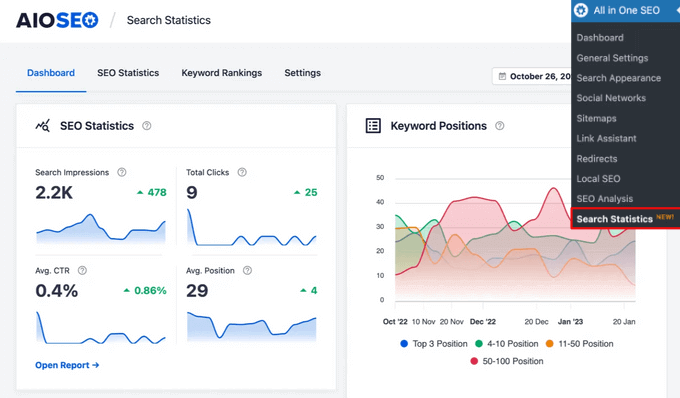
This will take you to the Search Statistics dashboard, where you can view an overview of the following:
- SEO Statistics – Search impressions, total clicks, average click rate (CTR), and average position for all content.
- Keyword Location – The average position of keywords in Google search results.
- Keyword ranking – keywords that rank high on your content and win/fail keywords that change the most in Google search results.
- Content Performance – The home page on your website, as well as the winning/failed pages that change in Google search results.
To learn more about the keywords for your blog post rankings, you can click the Keyword Ranking tab.

Then, scroll down to the Keyword Effects table to see the best-performing keywords.
If you want, you can use the built-in search feature to find specific keywords that interest you. Alternatively, you can click the "Most Loss" or "Most Profit" tab to view only these keywords.
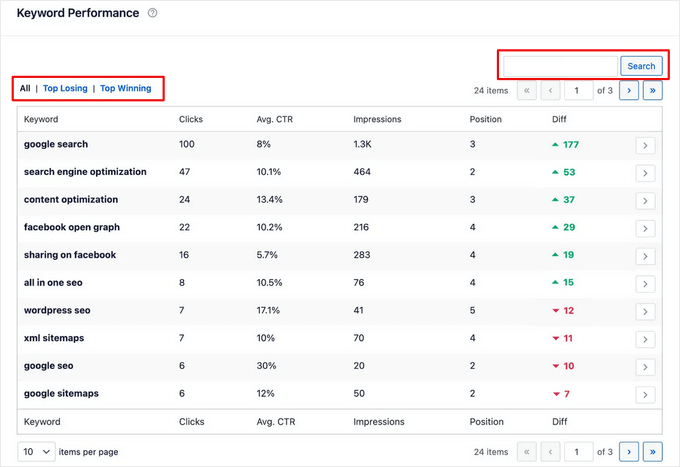
You can also click on any keyword in the table to see what the keyword ranks.
Here you will also see statistics such as click count, average click rate, etc.
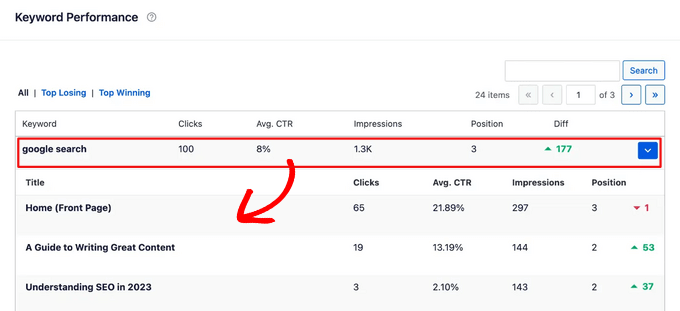
Most importantly, AIOSEO has recently added a powerful content ranking report to the Search Statistics plugin.
The search ranking of content may drop because it is not optimized. However, with this report, you can easily spot content decay and important content performance trends.
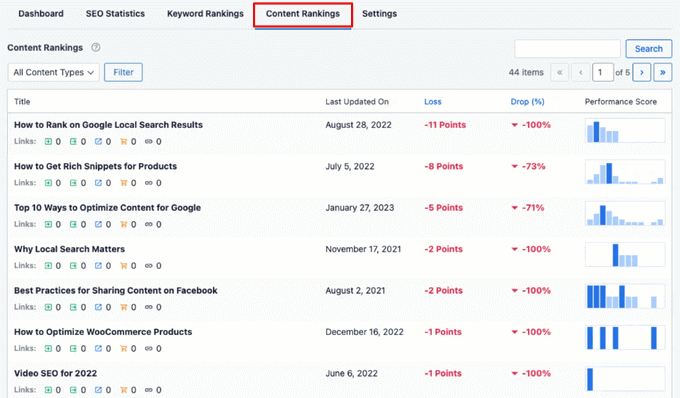
It will display the date the URL was last updated, the speed of content decay, the percentage of content decay points drop/increase, detailed SEO data about each URL, and insights on optimized content.
AIOSEO also offers built-in SEO advice to help you improve keyword rankings, automatic internal links, social media integration, enrich summary architecture tagging, and more.
Method 4: Use Ahrefs to check keyword rankings

Ahrefs is another popular SEO tool among professional marketers. It comes with an easy-to-use interface and tries to make information understandable to new users as well.
Simply enter your website domain name in the search box and it will create a well-organized report with beautiful graphics and charts.
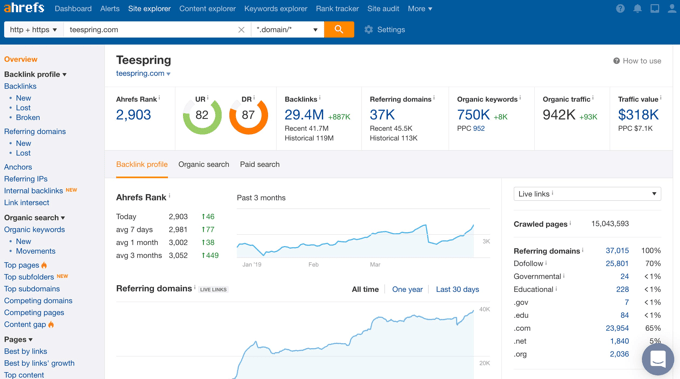
You will find all keyword rankings in the Organic Keywords Report.
Next to each keyword, you will be able to see its search volume, keyword ranking position, keyword density, and more.
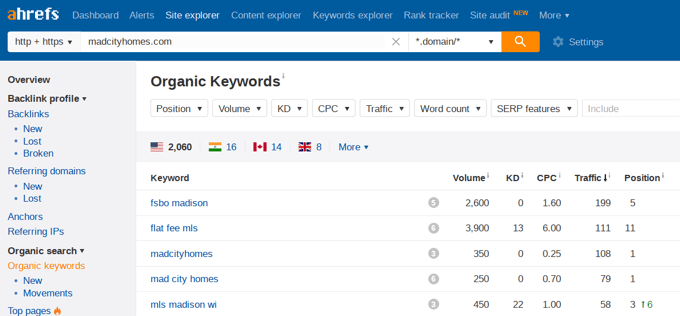
Get more traffic in WordPress using keyword ranking
Now that you have learned how to check keyword rankings for your WordPress blog, let’s talk about how to improve your rankings.
How to analyze which keywords need improvement
When you decide which keywords to improve, it is important to note that not all keywords are the same.
For example, the 5th place in high traffic keywords is much better than the 1st place in low traffic keywords.
Also, being in the No. 1 doesn’t always bring you the most traffic. You may notice that while some of your keywords rank well, they don't get a lot of clicks or impressions.
During your research, you may also find some surprising keywords that you don’t know your ranking.
If these keywords have a large number of impressions and searches, you should see if you can make strategic changes to your content to improve the ranking of these keywords.
How to improve the ranking of specific keywords
After deciding which keywords you need to deal with, you can continue to see which articles rank on those keywords and what steps you can do to better optimize them.
Here are some tips.
If you use the all-in-one SEO plugin, you can find useful suggestions on how to improve these important keywords. When editing a post, simply scroll down to the AIOSEO settings at the bottom and you will find the Focus Keywords and Other Keywords fields.

Simply enter the most important keywords for the post in the "Focus Keywords" field and click the "Add Focus Keywords" button. You can add additional keywords as additional keyword phrases.
All-in-one SEO now analyzes the content of your specific keyword and shows you scores and practical tips for improving the content of that keyword.
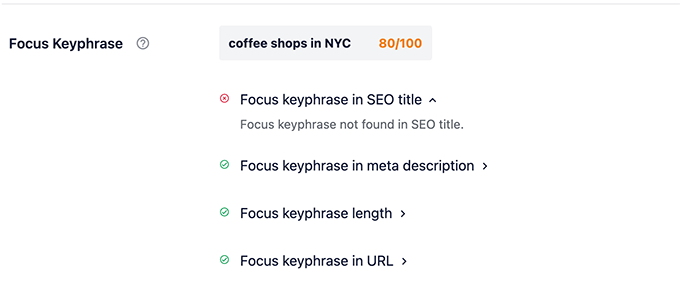
To learn more, see the beginner's guide on how to use focus keywords in WordPress.
Next, you should look for old, inadequate or outdated articles. Update these articles with updated information and improve content can bring them a search engine optimization (SEO) improvement.
Finally, see if you can improve internal links, i.e. where links to articles from other pages of the website. Links to articles in other related posts can give it a search engine optimization (SEO) improvement. When linking to the target keyword from other articles on your website, use your target keyword as the anchor text.
For more details on this topic, see our article on how to optimize WordPress blog post for SEO.
Understand the behavior of visitors on your website
Semrush and Google Search Console can help you find keyword locations, but they can't show you how many visitors are visiting your post, where they come from, and what they do on your website.
This information is crucial when planning content strategies to rank certain keywords.
This is where Google Analytics comes into play. It will show you the comprehensive views, popular content, visitor information, etc. of the article.
Google Analytics can be difficult for beginners to set up, which is why we recommend using MonsterInsights. It is a Google Analytics plugin for WordPress that helps you easily install Google Analytics and view all reports in your WordPress dashboard.
To learn more, see our guide on how to track website visitors to your WordPress site.
We hope this post helps you check if your WordPress posts rank for the correct keywords. You may also want to check out our guide on how to keep your website safe and the best analytics solutions our experts have selected for WordPress users.
The above is the detailed content of How to check if your WordPress blog post ranks for the right keywords. For more information, please follow other related articles on the PHP Chinese website!

Hot AI Tools

Undress AI Tool
Undress images for free

Undresser.AI Undress
AI-powered app for creating realistic nude photos

AI Clothes Remover
Online AI tool for removing clothes from photos.

Clothoff.io
AI clothes remover

Video Face Swap
Swap faces in any video effortlessly with our completely free AI face swap tool!

Hot Article

Hot Tools

Notepad++7.3.1
Easy-to-use and free code editor

SublimeText3 Chinese version
Chinese version, very easy to use

Zend Studio 13.0.1
Powerful PHP integrated development environment

Dreamweaver CS6
Visual web development tools

SublimeText3 Mac version
God-level code editing software (SublimeText3)

Hot Topics
 What are the mainstream public chains of cryptocurrencies? The top ten rankings of cryptocurrency mainstream public chains in 2025
Jul 10, 2025 pm 08:21 PM
What are the mainstream public chains of cryptocurrencies? The top ten rankings of cryptocurrency mainstream public chains in 2025
Jul 10, 2025 pm 08:21 PM
The pattern in the public chain field shows a trend of "one super, many strong ones, and a hundred flowers blooming". Ethereum is still leading with its ecological moat, while Solana, Avalanche and others are challenging performance. Meanwhile, Polkadot, Cosmos, which focuses on interoperability, and Chainlink, which is a critical infrastructure, form a future picture of multiple chains coexisting. For users and developers, choosing which platform is no longer a single choice, but requires a trade-off between performance, cost, security and ecological maturity based on specific needs.
 Cardano's smart contract evolution: The impact of Alonzo upgrades on 2025
Jul 10, 2025 pm 07:36 PM
Cardano's smart contract evolution: The impact of Alonzo upgrades on 2025
Jul 10, 2025 pm 07:36 PM
Cardano's Alonzo hard fork upgrade has successfully transformed Cardano from a value transfer network to a fully functional smart contract platform by introducing the Plutus smart contract platform. 1. Plutus is based on Haskell language, with powerful functionality, enhanced security and predictable cost model; 2. After the upgrade, dApps deployment is accelerated, the developer community is expanded, and the DeFi and NFT ecosystems are developing rapidly; 3. Looking ahead to 2025, the Cardano ecosystem will be more mature and diverse. Combined with the improvement of scalability in the Basho era, the enhancement of cross-chain interoperability, the evolution of decentralized governance in the Voltaire era, and the promotion of mainstream adoption by enterprise-level applications, Cardano has
 Leading the top 20 token rankings in the 2025 crypto market (Latest update)
Jul 10, 2025 pm 08:48 PM
Leading the top 20 token rankings in the 2025 crypto market (Latest update)
Jul 10, 2025 pm 08:48 PM
The top 20 most promising crypto assets in 2025 include BTC, ETH, SOL, etc., mainly covering multiple tracks such as public chains, Layer 2, AI, DeFi and gaming. 1.BTC continues to lead the market with its digital yellow metallicity and popularization of ETFs; 2.ETH consolidates the ecosystem due to its position and upgrade of smart contract platforms; 3.SOL stands out with high-performance public chains and developer communities; 4.LINK is the leader in oracle connecting real data; 5.RNDR builds decentralized GPU network service AI needs; 6.IMX focuses on Web3 games to provide a zero-gas-free environment; 7.ARB leads with mature Layer 2 technology and huge DeFi ecosystem; 8.MATIC has become the value layer of Ethereum through multi-chain evolution
 Which chain does Dogecoin DOGE belong to? Does Dogecoin belong to the Binance Chain?
Jul 10, 2025 pm 08:39 PM
Which chain does Dogecoin DOGE belong to? Does Dogecoin belong to the Binance Chain?
Jul 10, 2025 pm 08:39 PM
Recently, the discussion in the digital asset field has remained hot. Dogecoin DOGE, as one of the most popular focus, has become a question that many people have explored. Where does it "settling down"? What is the relationship with the current leading trading platform, Binance? To answer these questions, we need to conduct in-depth analysis from the two dimensions of the underlying technical logic of digital assets and the platform ecology, rather than just staying in appearance.
 Comparison of the differences and advantages and disadvantages of USDC, DAI, and TUSD (recently updated)
Jul 10, 2025 pm 09:09 PM
Comparison of the differences and advantages and disadvantages of USDC, DAI, and TUSD (recently updated)
Jul 10, 2025 pm 09:09 PM
The core difference between USDC, DAI and TUSD lies in the issuance mechanism, collateral assets and risk characteristics. 1. USDC is a centralized stablecoin issued by Circle and is collateralized by cash and short-term treasury bonds. Its advantages are compliance and transparent, strong liquidity, and high stability, but there is a risk of centralized review and single point failure; 2. DAI is a decentralized stablecoin, generated through the MakerDAO protocol, and the collateral is a crypto asset. It has the advantages of anti-censorship, transparency on chain, and permission-free, but it also faces systemic risks, dependence on centralized assets and complexity issues; 3. TUSD is a centralized stablecoin, emphasizing real-time on-chain reserve proof, providing higher frequency transparency verification, but has a small market share and weak liquidity. The three are collateral types and decentralization
 What are the most promising cryptocurrencies? Can ordinary people make money by buying cryptocurrencies?
Jul 10, 2025 pm 08:24 PM
What are the most promising cryptocurrencies? Can ordinary people make money by buying cryptocurrencies?
Jul 10, 2025 pm 08:24 PM
Whether ordinary people can make money by participating in the cryptocurrency market depends on multiple factors, and opportunities and risks coexist. This article introduces mainstream projects such as Bitcoin, Ethereum, Solana, BNB and Cardano. The highlights are market consensus, smart contract ecosystem, high-performance public chains, platform resource support and technical rigor; potential opportunities include high growth potential, technological innovation and low entry threshold, but risks are also significant, such as large price fluctuations, technical complexity, security issues and regulatory uncertainty; for beginners, it is recommended to follow the following steps: 1. Independent research (DYOR); 2. Select a reliable trading platform; 3. Complete identity verification; 4. Small batch investment; 5. Learn to keep assets safely. Overall, the cryptocurrency market has potential, but it needs to be treated with caution
 What are the mainstream cryptocurrencies in the world? In-depth analysis of cryptocurrency in 2025 (including website)
Jul 10, 2025 pm 08:36 PM
What are the mainstream cryptocurrencies in the world? In-depth analysis of cryptocurrency in 2025 (including website)
Jul 10, 2025 pm 08:36 PM
At a time when the digital economy wave swept the world, cryptocurrencies have become the focus of attention from all walks of life with their unique decentralization and transparency. From the initial geek niche experiment to the current financial landscape with a market value of trillions, the evolution of cryptocurrencies is amazing. It not only brings innovations in underlying technologies, but also gives birth to countless innovative applications, which are profoundly affecting all aspects of finance, technology and even social governance.
 Ethereum's leap in scalability: How Layer 2 solutions shape the future
Jul 10, 2025 pm 08:00 PM
Ethereum's leap in scalability: How Layer 2 solutions shape the future
Jul 10, 2025 pm 08:00 PM
Ethereum Layer 2 (L2) expansion solution significantly improves efficiency and reduces costs by processing off-chain transactions. The main solutions include 1. Rollups (optimistic Rollup and zero-knowledge Rollup) performs computing in L2 and L1 storage data; 2. The state channel is suitable for off-chain high-frequency interaction; 3. The side chain provides independent blockchain and L1 connection; L2 makes micro payments and high-frequency transactions possible through batch processing of transactions and reducing Gas fees; at the same time, it empowers the application ecosystems such as DeFi, NFT and blockchain games, and is integrated by mainstream platforms such as Binance and Ouyi to achieve rapid asset transfer and promote the development of crypto asset liquidity.






